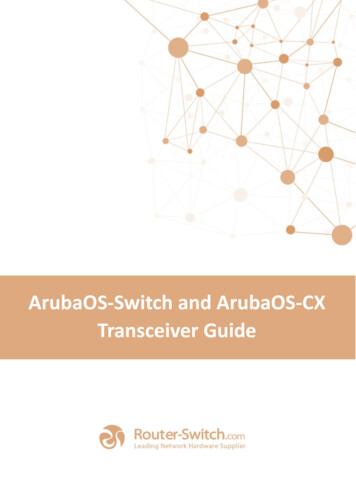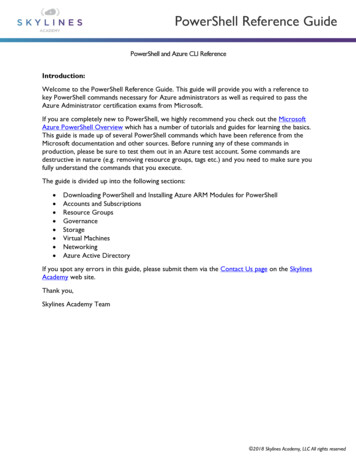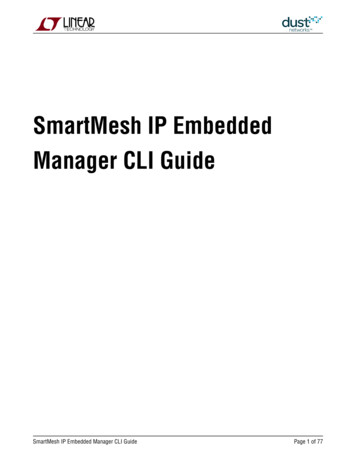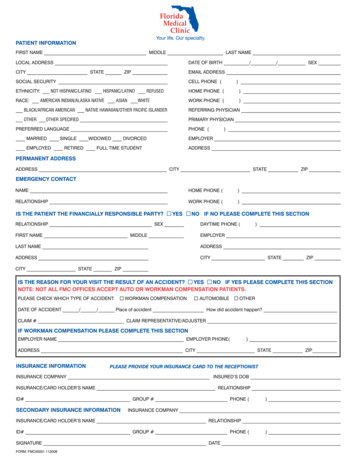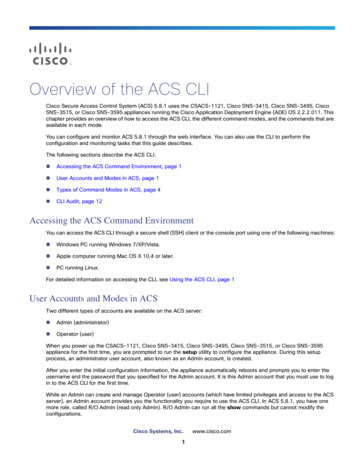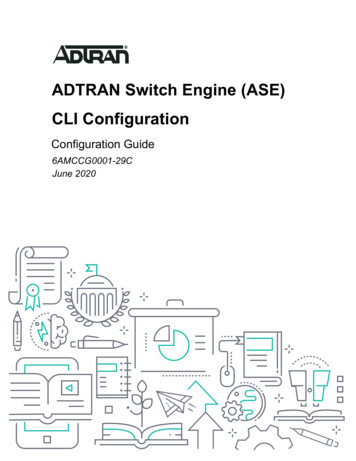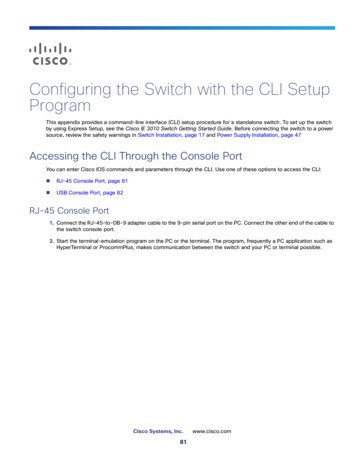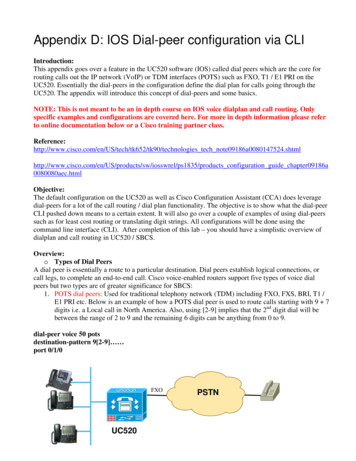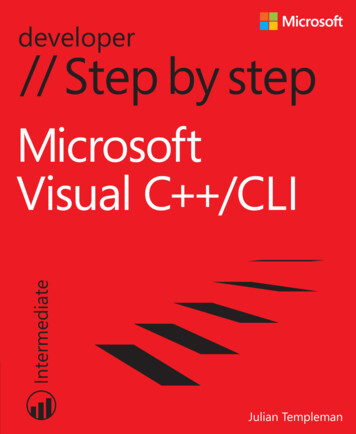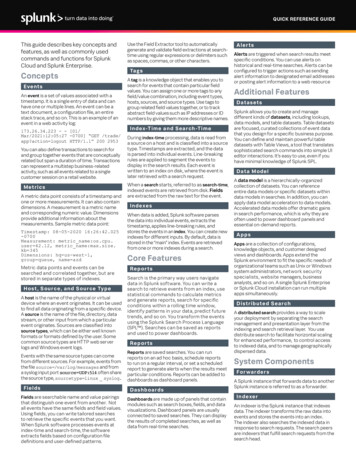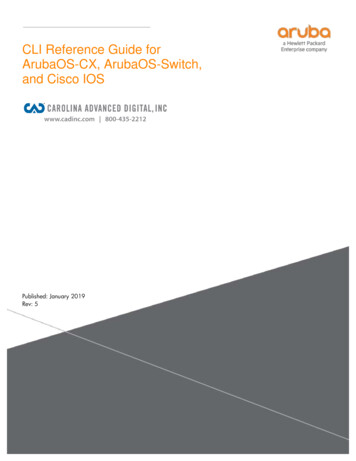
Transcription
CLI Reference Guide forArubaOS-CX, ArubaOS-Switch,and Cisco IOSPublished: January 2019Rev: 5
Table of ContentsIntroduction . 3Using This Guide . 4Navigation Differences Among CLIs. 4Configuration Differences Among CLIs . 4Terminology Differences . 5Disclaimer . 5Comparing View and Configuration Prompts . 5Comparing Frequently Used Commands . 6Chapter 1 Basic Switch Management . 7Management Access CLI comparision . 7Management Access Configurable options . 7Configuration Access CLI comparision . 8Configuration Access Configurable options . 8Console and Virtual Terminal Access—Timeout CLI comparision . 9Console and Virtual Terminal Access—Timeout Configurable options . 9Reload & Timed Reload CLI comparision . 11Reload & Timed Reload Configurable options . 11USB CLI comparision . 14USB CLI comparision Configurable options . 14System and Environment CLI comparision . 15System and Environment Configurable options . 15Remote Management Sessions—Viewing CLI comparision. 23Remote Management Sessions—Viewing CLI Configurable options . 23Tech Support Information Output Listing CLI comparision. 24Tech Support Information Output Listing CLI Configurable options . 24Motd CLI comparision . 26Motd CLI Configurable options. 26Source Interface for Management Communications CLI comparision . 26Source Interface for Management Communications CLI Configurable options . 27Chapter 2 Switch User ID and Password, and Console Access . 30
Local User ID and Password, and console access CLI comparision . 30Local User ID and Password, and console access CLI Configurable options . 31Recover lost password CLI comparision . 35Recover lost password CLI Configurable options . 35Role based management CLI comparision . 36Role based management CLI Configurable options . 36Chapter 3 Time Service . 44NTP CLI Comparison. 44NTP Service configurable options . 44Chapter 4 CLI Management Access – SSH . 50SSH CLI Comparison . 50SSH Service configurable options . 50Chapter 5 GUI Management Access – HTTPS . 56HTTPS CLI Comparision . 56HTTPS Service configurable options . 56Chapter 6 Discovery Protocols – LLDP. 58LLDP CLI Comparision . 58LLDP configurable options . 59Chapter 7 Out-of-Band Management . 65Out-Of-Band CLI Comparision . 66Out-Of-Band configurable options . 66Chapter 8 Interface or Port Information and Nomenclature . 77Interface or Port Information CLI Comparision . 77Interface or Port Information configurable options . 78Chapter 9 Link Aggregation – LACP and Trunk . 87Link Aggregation Control Protocol (LACP) CLI comparision . 88Chapter 10 MSTP . 95MSTP CLI Comparison. 95MSTP CLI Configurable options . 96Chapter 11 VRRP . 108VRRP CLI Comparison . 1081
VRRP CLI Configurable options . 109Chapter 12 ACLs . 116ACL CLI Comparison. 117ACL CLI Configurable options . 117Chapter 13 BGP . 122BGP CLI Comparison . 123BGP CLI Configurable options . 123Chapter 14 OSPF . 132OSPF CLI Comparison. 132OSPF CLI Configurable options . 133Appendix A CLI Commands in ArubaOS-Switch Software . 137Fundamental Commands . 1382
CLI Reference Guide for ArubaOS-CX, ArubaOS-Switch andCisco IOSIntroductionAruba designed this CLI Reference Guide to help Hewlett Packard Enterprise partners and customerswho: Manage multi-vendor networks that include HPE/Aruba and Cisco core and aggregationswitches Have experience deploying Cisco switches and are now deploying HPE/Aruba switchesThis CLI Reference Guide compares many of the common commands in three switch operating systems:ArubaOS-CX, ArubaOS-switch and Cisco IOS.In this guide, we refer to 8400 as ArubaOS-CX, HPE ProVision as ArubaOS-Switch, and Cisco IOS isreferenced as Cisco.The ArubaOS-CX operating system runs on the 8400, 8320 and 8325 switches. The ArubaOS-switchoperating system runs on Aruba 2530, Aruba 2920, Aruba 2930F, Aruba 2930M, Aruba 3810M,Aruba 5400R, HPE 2620, HPE 3500, HPE 5400 and HPE 3800 switch platforms.The commands included in this guide were tested on the following: Aruba 8400 – 8 slot chassis with dual management modules running ArubaOS-CX 10.01.0001Aruba 3810M-24G-PoE switch running ArubaOS-Switch KB.16.03.0003 Cisco switch running Cisco IOS Software 15.0(1)SE Additional Aruba and Cisco switches and/or routers were used to provide systems connectivity andoperational support as necessary. Likewise, various computers and Voice over IP (VoIP) phones wereused to help test functionality and provide output for commands such as show or display.3
Using This GuideThis CLI Reference Guide provides CLI command comparisons in two different formats: Side-by-side comparison—Provides a table of the basic commands required to execute a givenfunction in each of the operating systems. In this side-by-side comparison, each platform’scommands do not always start at the top of the column. Instead, commands that have similarfunctions are aligned side by side so that you can easily “translate” the commands on one platform with similar commands on another platform.Detailed comparison—Beneath the side-by-side comparison, this guide provides a more in-depthcomparison, displaying the output of the command and its options.Occasionally, the commands required to execute a function or feature in each operating system arecompletely different. In these instances, each column has the commands necessary to implement thespecific function or feature, and the side-by-side comparison does not apply.Navigation Differences Among CLIsBasic CLI navigation on all three platforms is very similar, with one notable difference: With ArubaOS-CX switches, you can use the Tab key for command completion; but you use the ?key to find more command options. Using tab key also displays the further suboptions without thehelp description.With ArubaOS-Switch, you can use the Tab key for command completion; you can also use theTab key or the ? key to find more command options. In addition, typing “help” at the end of acommand may provide additional descriptive information about the command.With Cisco, you can use the Tab key for command completion, but you use the ? key to find morecommand options.Configuration Differences Among CLIsFor interface IP addressing and interface-specific routing protocol configuration, you execute mostcommands differently depending on the platform: On ArubaOS-CX, you configure the aforementioned components in an interface (VLAN for switch)context. An Interface context can act as layer 3 after assigning an IP address converting it to aSwitch Virtual Interface (SVI) of switch ports. There is no physical interface for the VLAN and theSVI provides the Layer 3 processing for packets from all switch ports associated with the VLAN.There is a one-to-one mapping between a VLAN and SVI, thus only a single SVI can be mapped toa VLAN.On ArubaOS-Switch, you configure the aforementioned components in a VLAN context. A virtualLAN (VLAN) is any broadcast domain that is partitioned and isolated in a computer network atthe data link layer (OSI layer 2). VLANs can keep network applications separate despite beingconnected to the same physical network, and without requiring multiple sets of cabling andnetworking devices to be deployed.On Cisco, you configure the aforementioned components in an interface (VLAN for switch)context.4
Terminology DifferencesAmong the three operating systems, there are some differences in the terms used to describe features. Thetable below lists three such terms that could be confusing.In ArubaOS-CX Switches and Cisco, for example, the term trunk refers to an interface that you configureto support 802.1Q VLAN tagged frames. That is, an interface that you configure to support
This CLI Reference Guide compares many of the common commands in three switch operating systems: ArubaOS-CX, ArubaOS-switch and Cisco IOS. In this guide, we refer to 8400 as ArubaOS-CX, HPE ProVision as ArubaOS-Switch, and Cisco IOS is referenced as Cisco. The ArubaOS-CX operating system runs on the 8400, 8320 and 8325 switches. The ArubaOS-switch operating system runs on
